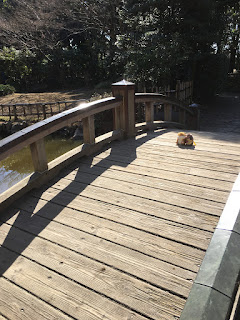¡Hola! Soy Enrique. Flake y Tigrecito hicieron buenas migas con mi perrito. ¡Aunque este perro parece un león!
Hacer buenas migas= Llevarse bien, hacerse amigos. Hit off.
Flake made really good friends with Enrique´s beautiful pet. Although he felt somewhat intimidated as it was his first time meeting a lion??? Flake felt relieved when Enrique told him that it was just a dog!
As the good tiger he is, Flake loves a good piece of meat. He was delighted when he got to try Spanish Jamón Serrano.
Do you know how Jamón Serrano is made? In case you were wondering...

Cuando hablamos de uno de los productos estrella de la gastronomía española como el jamón a todos se nos viene a la cabeza su increíble sabor, aroma y textura. Para ello es necesario someter al jamón a un proceso de curación que consiste en cuatro fases: salado, postsalado, secado/maduración y envejecimiento. Este proceso de elaboración es el mismo para el jamón ibérico y el serrano, la única diferencia es el tiempo de curación que tiene que ser de un mínimo de 24 meses para el ibérico y un mínimo de 210 días para el serrano. Además dentro de los jamones serranos existen distintas menciones en función de los tiempos de curación: Bodega (de 9 a 12 meses), Reserva (de 12 a 15 meses) y Gran Reserva (más de 15 meses).
Salazón. Es el primer paso en el proceso de curación del jamón y consiste en cubrir las piezas con sal común. Las condiciones de temperatura, humedad y ventilación de la cámara de salado deben conducir a la inhibición del desarrollo de microorganismos, así como evitar una desecación externa del jamón o paletilla que impediría la penetración de la sal hacia el interior de la pieza. Para este proceso la temperatura de la cámara debe estar entre 0 y 4º grados y la humedad relativa entre el 75% y el 95%.
Postsalado. Las piezas, colgadas en los pallets, son llevadas a las cámaras de postsalado; en esta etapa la sal y los nitrificantes van introduciéndose homogéneamente por el interior de la pieza inhibiendo el crecimiento microbiano y canalizando los procesos bioquímicos de hidrólisis responsables de producir el aroma y sabor tan característicos del jamón. El tiempo de permanencia de las piezas en esta fase comprenderá un periodo mínimo de 40 días.
Primera fase de secado. El secado es el tratamiento mediante el cual se reduce la cantidad de agua presente en los jamones y paletas. También tiene lugar el sudado o fusión natural de parte de las grasas de su tejido adiposo. Durante los primeros días después del postsalado, tiene lugar un secado lento de las piezas con unas condiciones de alta humedad relativa y temperaturas bajas que facilitan la difusión de la sal a través de la masa cárnica.
Segunda fase de secado. Durante esta fase prosigue la deshidratación paulatina del producto y el sudado de parte de las grasas. En esta fase se sube muy levemente la temperatura y se controla la humedad durante 30 días. Esta etapa se puede realizar en el mismo secadero o bien en una bodega controlando que la temperatura no exceda de 34º grados y la humedad relativa se encuentre en valores entre el 60% y el 80%.
Envejecimiento. Esta es una fase de afinamiento con el fin de que el jamón adquiera sus propiedades tan características de sabor, olor, color y textura. Las piezas se mantienen en la bodega natural donde son controladas las condiciones de temperatura y humedad. En esta fase las piezas permanecerán el tiempo requerido en función del producto a obtener (Jamón ETG, Jamón Consorcio Serrano, jamón/paleta curada y jamón/paleta ibérica).
Una vez finalizadas las 4 fases de curación se realiza la selección del producto donde se comprueba la consistencia del jamón y que esté correctamente curado. Si no está lo suficientemente firme se mantiene en las bodegas hasta que alcancen la curación óptima. En el caso del jamón serrano se puede considerar que el producto está listo cuando cumple con los 210 días de curación y tiene una merma mínima del 33% de su peso en fresco. En el jamón ibérico únicamente tiene la obligación de cumplir con el tiempo mínimo de curación (24 meses) y un peso mínimo de 7 kilos.
Desde hace más de 50 años en
Nico Jamones somos especialistas en la selección y curación de
jamones ibéricos y
serranos. Este cuidado proceso se lleva a cabo
en nuestros secaderos de Luciana (Ciudad Real) donde se mantienen los productos a las temperaturas y humedades más adecuadas en cada etapa del proceso, para obtener un producto de máxima calidad que destaca por su sabor y textura.
The Serrano ham production process includes four phases:
· Salting The fresh ham is covered with sea salt, which remains on the ham approximately 20 hours to two days per kilo of ham. In a curing area with a high degree of humidity, the pure salt stabilizes the product at a low temperature.
· Rest or Post-salting The hams are rinsed and the salt slowly and progressively diffuses through the meat, gradually equalizing throughout the ham.
· Dry Curing The fresh meat is hung in rooms that mimic the change of seasons, from the cold, moist air of winter to the dry heat of summer. As the fat melts away and chemical changes occur, the simple pork transforms into a beautifully cured ham.
Want to know more? Check it out here:






























